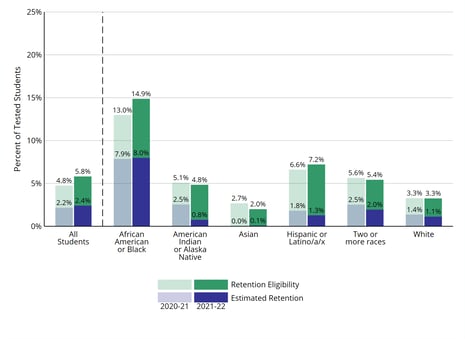Roughly 5,650 Michigan students received reading scores low enough that they could be required to repeat third grade, according to a new report from Michigan State University’s Education Policy Innovation Collaborative, or EPIC, the strategic research partner of the Department of Education and local school districts in Michigan.
In the spring of 2022, nearly all students in third through eighth grades (M-STEP in grades three through seven, PSAT in eighth grade) took the Michigan Student Test of Educational Progress, or M-STEP, after two years of disruptions by the COVID-19 pandemic. With 95% of students taking the test in 2022, compared to just 71% last year, more students scored below 1252, the state-determined benchmark for one grade level behind in reading, and could be held back under Michigan’s Read by Grade Three law.
A higher proportion of students who took the test in 2022 scored 1252 or below than in 2021. Overall, 5.8% of third graders who took the English language arts, or ELA, M-STEP received scores that make them eligible to be retained according to the law. This is a full percentage point higher than the percent of tested third-grade students who were one grade level behind in reading in 2021 (4.8%).
According to Katharine Strunk, director of EPIC, and the Clifford Erickson Distinguished Professor of Education Policy in MSU’s College of Education, this provides more evidence that students will need additional support to recover from missed opportunities to learn caused by the pandemic.
“More than anything, this shows us that the pandemic has taken a toll on many of Michigan’s students, and more are struggling with literacy in the third grade than were prior to the pandemic,” Strunk said. “Michigan’s schools and students will need increased investments and support to recover academically.”
Nearly 15% of tested Black third graders in Michigan are eligible for retention, as are 7% of Latino students, 9% of economically disadvantaged students and 11% of students with disabilities. These groups of students have notably higher retention-eligibility rates than their peers. For instance, Black students are 4.5 times more likely to be retention-eligible than their white peers, and economically disadvantaged students are 4.5 times as likely to be retention-eligible than their more advantaged peers.

"Retention eligibility” measures the percentage of tested students who scored 1252 or below on the third-grade ELA M-STEP (one grade level behind). “Estimated retention” measures the percentage of tested students who were retention-eligible but qualify for a good cause exemption and therefore should not be retained under the law.
There are also substantial disparities across types of schools and districts: One in four students in Partnership schools — the state’s lowest-performing schools – are retention-eligible, compared to one in 20 students in non-Partnership schools. Nearly 18% of students in districts that have previously scored in the bottom quartile of ELA achievement are retention eligible relative to 2% of students in the highest-scoring districts. These gaps have increased slightly since the 2020-21 school year.
“These data are of significant concern and point to the fact that, while many are rebounding from the adverse impact of the pandemic, others who were among those most in need pre-pandemic appear to be among those most adversely affected in and by the pandemic,” said State Superintendent Michael Rice. “The joint effects of historic underfunding of schools for many years in the state, a related teacher shortage and a pandemic have taken their toll.
“That said, the budget recently negotiated between the governor and state Legislature is an extraordinary one. The budget adds $450 per student in base funding, $246 million for students with disabilities, $232 million for economically disadvantaged students, $575 million to begin to address the teacher shortage and $245 million to help address children’s mental health challenges. Over a period of time, these new funds will help us fill more classrooms with certified teachers and support staff, provide professional development to more early-elementary teachers in research-based literacy instruction, lower early-elementary class sizes in some districts whose class sizes are too high, reduce and ultimately eliminate the teacher shortage, and provide needed tutoring and mentoring supports for those in need.
“Coupled with the current fiscal year 2022 budget, the fiscal year 2023 budget permits the expansion of preschool by another 23,000 students annually in the next few years, another effort that will help improve literacy and other outcomes for Michigan children in the future.”
In May and June, the state sent letters to the residences of all students eligible for retention under the law. However, it is not likely that all these students will be held back because the law allows for “Good Cause Exemptions” for some students, including English learners with fewer than three years of English language instruction; students with an Individualized Education Program or Section 504 Plan; students who were previously retained and received intensive reading interventions for two or more years; and students who have been enrolled in their current districts for fewer than two years and were not provided with an appropriate individual reading improvement plan.
Once the analysis accounts for the factors that may qualify students for good cause exemptions, an estimated 2.4% of tested third-grade students could be retained under the Read by Grade Three Law. This is slightly higher than the estimated 2.2% retention rate from the 2020-21 school year.
Note: “Retention eligibility” measures the percentage of tested students who scored 1252 or below on the third-grade ELA M-STEP (one grade level behind). “Estimated retention” measures the percentage of tested students who were retention-eligible but qualify for a good cause exemption and therefore should not be retained under the law.
Districts that primarily provided remote instruction in 2020-21 had the largest share of students flagged for retention, based on their spring 2022 ELA M-STEP scores, with more than twice the retention-eligibility rates as districts providing in-person or hybrid instruction. However, these districts would also have had higher retention-eligibility rates than in-person and hybrid districts in 2018-19 if the retention policy had been in effect at the time, suggesting that these gaps are driven in part by differences in district-average achievement that pre-date the pandemic. Still, although retention-eligibility rates increased from 2018-19 to 2021-22 across districts in all three modality categories, districts that were primarily remote in 2020-21 experienced the largest increase in the share of students flagged for retention.
Strunk noted, “It is particularly concerning that retention eligibility rates are higher for historically marginalized students and for those who learned remotely during the 2020-21 school year. The road to recovery will be longer and steeper for some students than others and the long-term implications of these disparities will be dire for both the individual students and the state if we do not work quickly to address them.”
